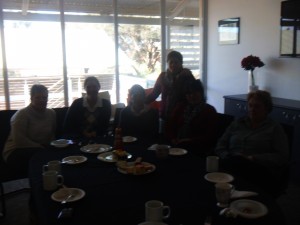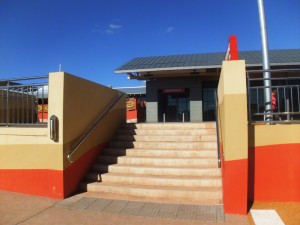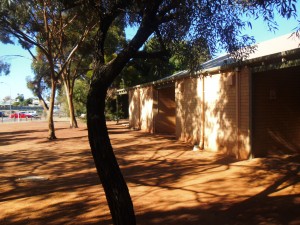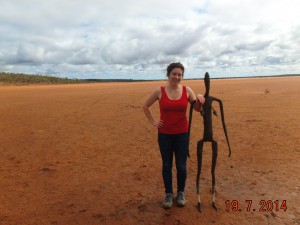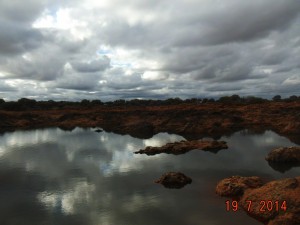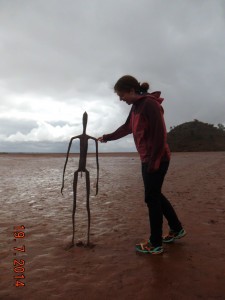I left you last time on a quiet Thursday night in Kalgoorlie, (which I am now going to call ‘Kal’ like the locals do. Partly because I almost feel like a local, partly also because Kalgoorlie is a pain to type). So now I have an entire weekend and a full week on the paediatric team to document, which means this blog post features significantly more R and R and some Australian sites.
Somewhat unfortunately for the lovely Paediatric consultant who took us out on Saturday, the main sites of interest around Kalgoorlie are water related; an area in which it is hard to impress kiwis. Never mind, the principle feature of Lake Ballard, our first port of call, is the absence of water. It is a huge salt lake that has dried up, leaving behind (usually) a thin layer of salt across the entire surface.When we visited though, it had rained just enough to be a lake of red mud instead, which we walked gingerly across to see some of the 51 statues which are scattered 10km across lake Ballard as part of an enourmous installation put there a few years ago. They are theoretically modelled on people from the surrounding area who all seem to be quite closely related.
We then went off to see Niagara dam, named with a naïve sense of optimism, it would seem. It was absolutely gorgeous, but I was struggled to appreciate it as the huge body of water that it technically is. In WA at least. One thing that is incredible is the huge distances involved. A quick side trip to see Nigara was about a 100km round trip, featuring exactly no hills, quite a lot of trees, and a couple of dead animals.
The next day we went to the boulder markets and discovered that even though New Zealand still does coffee better, Australia probably does the best doughnuts. We also saw the major employer in the area, the Kalgoorlie Superpit.Essentially, all of the claims in the surrounding area were bought up and amalgamated into a giant open cast hole, out of which they are still dragging gold well over a century after it was first discovered. It then goes through part of the extraction process in the delightfully named ‘Gudgee roaster’; which you have to pronounce in an Australian accent in order to fully appreciate.
Medically, I spent the week with the paediatric team, who were universally lovely.
In the ward there was one patient who had a re-occurrence of rheumatic fever and was going to be in hospital, where his mother is also staying, for at least 3 weeks, on bed rest until the visiting cardiologist arrives. The whole situation made me think of hospitals 50 years ago where interventions were limited and bed rest and very extended stays were the norm.
Due to the fact this boy comes from an extremely remote area, had originally been non-compliant, and still has an extremely high ESR, this was the best option for him, as un-ideal as it appeared to be. Almost every other case on the paediatric ward was bronchiolitis, which hopefully I should be able to diagnose just about on the spot now! (perhaps that is a slight exaggeration.)There was also a baby born who, prenatally, had been high suspicion for Edward’s syndrome, based on some soft indicators. Luckily, the baby was absolutely free of birth defects, which was a huge relief to everyone concerned, and he was able to be cuddled by his mother before she was whisked off to theatre for extraction of the placenta after the cord snapped! She also did well, and it was a pleasure to see them doing so well over the next few days, right up to discharge where I was able to examine a completely healthy baby! There are still genetic studies to be returned, but the paediatric team are quite reassured that all is fine.
My time on the paediatric team has actually made me consider paediatrics, which had never really occurred to me before. I spent a lot of time on Paediatrics trying to see as many children as I could, most of who were normal aside from (usually) bronchiolitis, which was great because I was able to get a better feel for toddlers and babies. We also had some very good teaching with the interns and RMOs on febrile children; a major presenting complaint of children in ED.Another very interesting case I saw was that of a young girl who had a lung abcess who was sent to Perth to more extensive drainage as the fluid in it had become sequestered in multiple compartments, making it very difficult to remove. The interesting bit was what happened when she came back to Kalgoorlie.
Perth is a 7 hour trip from Kalgoorlie by road, so the girl and her mother were on the road by mid afternoon, but not back in Kalgoorlie until 10pm. On the phone, it had been implied (or stated, my view of the situation was somewhat third hand) that she had an IV line in for the continuation of the last few days of her antibiotics. She did not.
This meant that the paediatricians on call spent a rather traumatic time trying to get another IV line in one of the few remaining decent veins this girl had. By the next day, issues with Perth notwithstanding, she and her mother were much more relaxed to be at home in Kalgoorlie and were able to go home within the week.This was great to see as it illustrated a really nice aspect of rural medicine. When people are in their hometowns (especially children) they and their caregivers can often be so much more happy and settled, something which rural patients may not get to experience, especially as fewer and fewer services are available on location rurally.
I spent some time on my last afternoon in Kal checking out the museum, then we went out to dinner with some of the ED doctors. I then went to Perth for the day and ended up meeting one of the Kal students who was in Freemantle on her way back for the start of term. She had a bunch of other medical students from Notre Dame university with her too, so I was well compensated for the lack of other med students over the last few weeks! Notre Dame students are all post graduate and do a 4 year medical degree, so they had interesting a varied experiences prior to medicine, which is something I appreciated, having gone in out of high school!
Kalgoorlie overall was a great place, with a great team of dedicated people dealing with some quite extreme conditions. I really enjoyed my time there and hope I can apply the things I have learned back home. I am incredibly grateful to the Pat Farry Trust for giving me this opportunity.

